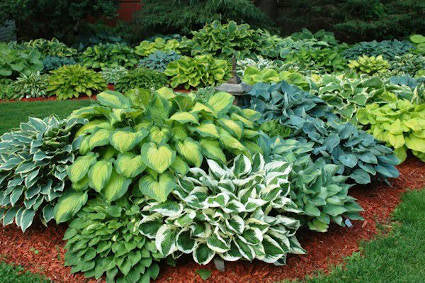
The Incredible Hosta
Share
The Incredible Hosta
Whether you call them hostas, plantain lilies or giboshi, these hearty foliage plants are a garden staple. They are long-lived (sometimes even outliving the gardener!), reliable and quite easy to grow. Hostas are members of the Asparagaceae family. They are herbaceous perennial plants native to northeast Asia. They grow from rhizomes or stolons and have broad lanceolate or ovate leaves. Depending on the plant species, the size of the leaves varies widely from 1-18” (3-45 cm) long and 0.75-12” (2-30 cm) broad. However, variation among cultivars is even greater.
Hostas come in many sizes, shapes and colors. While leaf color is mostly green, some varieties’ leaves appear blue. The color variation is attributed to a glaucous waxy leaf coating. Other varieties have a glaucous white coating on the underside of their leaves. The leaves of hostas vary further with variegation. Leaf variegation is a natural mutation in which the centers or edges of the plants’ leaves are either white/cream or yellowish in appearance.
Hostas produce lovely flowers that are taller than the leaf mound and range in color from white, lavender, pink or violet. Generally, the flowers are on upright scapes and pendulous attracting hummingbirds. The “August Lily” particularly stands out. It is nocturnal producing strongly fragrant white flowers that open in the evening and close by morning.
Hostas are extremely appealing because they are easy to grow. They pack a wallop in appeal because they are shade tolerant. Plus, they look beautiful making them striking garden focal points. With over 6,100 registered and named varieties, these immensely popular plants are edible and grown as vegetables in certain Asian cultures. Albeit, they are usually grown for ornamental purposes in the U.S. While they are fine for human consumption, the saponins contained in hostas make them toxic to dogs and cats.
Deer, rabbits, slugs and snails have no issues with the saponins. They are drawn to hostas and enjoy consuming them inflicting extensive damage. Deer and rabbits can be deterred by fencing or motion activated sprinklers. Slugs can be hand picked off your hostas at night when they feed. Dispose of them by dropping them into a bucket of soapy water. Snails are attracted to sweets. You can eradicate them by placing 4” wide strips of newspaper around the perimeter of your Hosta bed. Be sure to have the strips overlap. Soak them with your garden hose. Then sprinkle sugar along the center of the newspaper strips. Cover your handy work with scrap boards. The snails will flock to the sugar and take sanctuary in the cool shade. An hour or two before sunset, remove the scrap boards and gather the throng of snails. Dismiss them from your garden permanently by dumping them into a bucket of soapy water.
Keep your hostas happy by applying a well-balanced, slow-release fertilizer in the spring. Their soil should be moist but not wet. Achieve the desired level of moisture by placing mulch around the plants. Encourage growth by removing flower stalks after they’ve bloomed. Keep your hostas tidy by removing brown leaves in the autumn. This will also keep disease and slugs at bay. With a little bit of TLC from you, your hostas will thrive and dazzle you in return for many years to come.